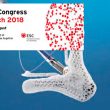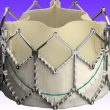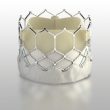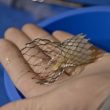Courtesy of Dr. Carlos Fava. In secondary mitral regurgitation, mitral-valve leaflets and chordae are structurally normal and mitral regurgitation results from alterations in left ventricular geometry and function. At present, prognosis is based on ventricular function and the regular course of action is optimal medical treatment. Even though some studies have shown edge-to-edge percutaneous repair<a href="https://solaci.org/en/2018/08/30/esc-2018-mitra-fr-testing-mitraclip-for-secondary-mitral-regurgitation/" title="Read more" >...</a>
Urgent/Emergent TAVR: A Valid Option
Courtesy of Dr. Carlos Fava. Aortic stenosis with cardiac failure or cardiogenic shock involves high mortality risk at short term. Surgery in these conditions is often unsafe, which leaves us with valvuloplasty, but only as a bridge to some other procedure, seeing as it is effective only for a short time. Few studies have looked into patients undergoing<a href="https://solaci.org/en/2018/06/20/urgent-emergent-tavr-a-valid-option/" title="Read more" >...</a>
Permanent Pacemaker: still TAVR’s Aquila’s Heel
TAVR has shown benefits in high risk patients (prohibitive) and in intermediate risk patients, but the need for permanent pacemaker implantation (PPI) continues to be a soft spot (especially in younger patients) given time of use, eventual replacement and associated complications. Even though there is little information on PPI, pacemakers are not associated with higher mortality, but they<a href="https://solaci.org/en/2018/04/04/permanent-pacemaker-still-tavrs-aquilas-heel/" title="Read more" >...</a>
WIN TAVI: The Largest Female TAVR Registry So Far
Courtesy of Dr. Carlos Fava. In most randomized or observational studies, women comprise more than 50% of patients undergoing TAVR, and they have showed better evolution, compared against surgery. The main differences between men and women with severe aortic stenosis are that women have smaller annular dimension, shorter distance to coronary ostia, smaller peripheral arteries, and<a href="https://solaci.org/en/2018/01/24/win-tavi-the-largest-female-tavr-registry-so-far/" title="Read more" >...</a>
Failing Surgical Bioprosthesis: A Challenge on the Rise
Courtesy of Dr. Carlos Fava. The gold standard for failing aortic bioprosthesis has traditionally been surgery. However, since the first valve in valve (TAV-in-SAV) report in 2007, by Wenaweser, transcatheter valve implantation has emerged as a valid alternative. Even so, at present there is not enough scientific evidence in this regard. The present study analyzed<a href="https://solaci.org/en/2017/12/15/failing-surgical-bioprosthesis-a-challenge-on-the-rise/" title="Read more" >...</a>
The SOURCE 3 Confirms the Good Outcomes of the SAPIEN 3 at One Year Followup
Transcatheter aortic valve replacement (TAVR) was developed as a strategy to treat non-surgical aortic stenosis, and was later expanded to elderly patients at intermediate risk, because of increased operator experience (overcoming the learning curve) and improved devices. The present study presents the one year outcomes of the SOURCE 3 trial, the multicenter European registry of the<a href="https://solaci.org/en/2017/10/27/the-source-3-confirms-the-good-outcomes-of-the-sapien-3-at-one-year-followup/" title="Read more" >...</a>
Paravalvular Leak in Surgical Prosthesis: How to Treat Them
Courtesy of Dr. Carlos Fava. The presence of paravalvular leaks (PVL) after aortic valve replacement ranges between 5% and 20%. Percutaneous repair has emerged as a feasible alternative, effective and safe, to prevent new surgery. The study included 86 patients undergoing aortic valve replacement presenting PVL with cardiac failure CFIII or IV and/or anemia.<a href="https://solaci.org/en/2016/12/26/paravalvular-leak-in-surgical-prosthesis-how-to-treat-them/" title="Read more" >...</a>
VII Latin American Symposium on Structural Cardiomyopathy
Do you need an update on Structural Cardiomyopathy? If so, clear your schedule from July 27 thru 29. We are hosting the 7th Latin American Symposium on Structural Cardiomyopathy, to be held at the Intercontinental Hotel in Cali, Colombia, organized by Angiografía de Occidente S.A. Featuring lectures of national and international relevance and the presence<a href="https://solaci.org/en/2016/05/27/vii-latin-american-symposium-on-structural-cardiomyopathy/" title="Read more" >...</a>
TAVI in asymptomatic severe aortic stenosis?
Original Title: Natural history, diagnostic approaches, and therapeutic strategies for patients with asymptomatic severe aortic stenosis. Reference: Généreux P et al. J Am Coll Cardiol. 2016; Epub ahead of print. Given that transcatheter aortic valve replacement (TAVI) is now being prescribed to lower risk patients, some wonder whether it is time to study the benefit<a href="https://solaci.org/en/2016/04/24/tavi-in-asymptomatic-severe-aortic-stenosis/" title="Read more" >...</a>
Transcatheter Tricuspid Valve in valve
Original Title: Transcatheter Tricuspid Valve-in-Valve Implantation for the Treatment of Dysfunctional Surgical Bioprosthetic Valve. An International, Multicenter Registry Study. Reference: Doff B. McElhinney, et al. Circulation 2016;133:1582-93 Courtesy of Dr. Carlos Fava. Transcatheter tricuspid valve in valve implantation (TVIV) is infrequent, complex and biological valves last from 10 to 15 years. Reoperation is associated with high<a href="https://solaci.org/en/2016/04/21/transcatheter-tricuspid-valve-in-valve/" title="Read more" >...</a>








